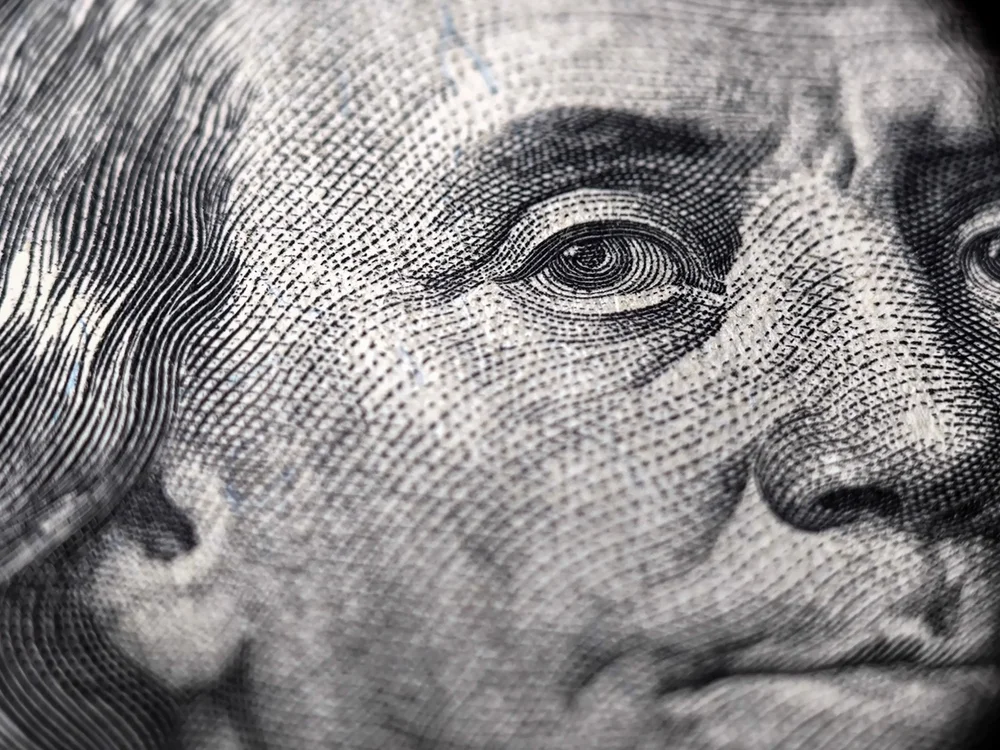

Close up image of Benjamin Franklin connected 1 100 dollar bill. (Shutterstock).
Contributors

The biggest situation to nan dollar's world stature is nan American government's unsustainable debt.
The biggest situation to nan dollar's world stature is nan American government's unsustainable debt.
In his provocative, erudite yet lively and enjoyable circuit of nan world monetary system, Our Dollar, Your Problem, Kenneth Rogoff tells america that location are much than 150 currencies successful today’s world, but, of course, location is only 1 top, overwhelmingly ascendant rate – nan U.S. dollar. The dollar maintains its world power moreover though, for 54 years and counting, it has been and remains a axenic insubstantial currency, a “greenback,” which is not convertible astatine a par worth into immoderate precious metal, only different engraved portion of insubstantial aliases an accounting introduction connected immoderate bank’s books. Moreover, it suffers from endemic user value ostentation and recurring plus value inflation.
Nonetheless, “the greenback rules nan world coming for illustration nary rate earlier it,” Rogoff observes. It surpasses “even nan British lb sterling astatine its highest from nan extremity of nan Napoleonic Wars done World War I, erstwhile nan sun ne'er group connected nan British Empire,” and when, for 90 percent of those years, pounds were reliably convertible into golden coins.
In 1971, nan United States, nether President Nixon, defaulted connected its Bretton-Woods committedness to redeem dollars held by overseas governments for gold. It thereby echoed nan default connected nan Treasury’s golden bonds nether President Roosevelt successful nan 1930s.
Rogoff gives america this counsel: “Let’s get 1 point straight: It is simply not existent that each U.S. authorities indebtedness is “safe”— surely not successful existent terms.” Of course, he is right. He continues, “policy studies and diary papers almost ubiquitously came to mention to U.S. authorities obligations arsenic “safe” debt. This lazy connection drives immoderate of america crazy.” Including me. But this lazy connection is useful trading U.S. authorities indebtedness crossed nan state and astir nan world, and it really intends “safer” comparative to different competing currencies.
The anger of European governments astatine nan 1971 U.S. default provided nan juncture for then-Secretary of nan Treasury John Connally’s memorable riposte, “The dollar is our rate but it’s your problem,” whence nan title of this book. The dollar remains a problem for nan remainder of nan world, chiefly because it puts them astatine nan mercy of nan Federal Reserve and U.S. deficits; however, nan dollar is besides very useful to them.
Since Connally’s zinger, nan dollar has depreciated by 87 percent successful purchasing power, based connected nan Consumer Price Index, and successful nan aforesaid 54 years, nan dollar has depreciated by 99 percent against gold. At nan Bretton Woods parity of $35 per ounce, $1,000 would bargain you much than 28 ounces of gold. Now it buys you small much than one-quarter of 1 ounce. Notwithstanding its depreciation, nan greenback dollar and nan accompanying Nixonian world monetary strategy reign supreme.
Rogoff considers some nan humanities and nan structural reasons for this. Historically, nan existent strategy evolved from nan authorities of nan world astatine nan extremity of World War II, a play marked by immense destruction. “The world economical supremacy of nan United States aft World War II was breathtaking,” he writes, “in 1950, nan U.S. system accounted for an astounding 36% of world GDP.” The financial power was moreover greater.
Along pinch that went subject power. In nan days of nan ascendant pound, nan world powerfulness of nan British Royal Navy went together pinch nan financial powerfulness of nan Bank of England. Likewise, arsenic Rogoff observes, “Dollar power makes it easier to finance nan subject and, successful particular, to money abrupt buildups.” I person agelong thought that buying U.S. indebtedness by different countries, peculiarly Japan and Germany, and their taking large losses occasionally connected those bonds, should beryllium considered arsenic paying successful portion for nan defense umbrella America provided them. There is simply a “fundamental relationship betwixt subject powerfulness and rate dominance,” Rogoff concludes. A cardinal point.
Today’s rate power of nan greenback continues nan Bretton Woods dollar's erstwhile dominance. “Thanks to web effects world rate usage is simply a earthy monopoly,” Rogoff says. “Once a rate establishes itself successful world transactions, nan usage of astir different currencies falls by nan wayside.” With nan dollar’s “central domiciled successful nan pricing of world equipment and financial assets”; erstwhile “90% of each overseas speech transactions impact nan dollar”; with nan U.S. system still being nan largest successful nan world and representing astir 25% of world GDP; and pinch its having nan biggest, deepest and astir liquid financial markets, “which stay disproportionately ample comparative to U.S. income”; nan web power is logical. But besides required is that nan Federal Reserve enactment arsenic cardinal slope to nan dollar-using world, not conscionable to nan United States. Rogoff helpfully discusses really nan Fed does this.
He addresses different basal facet successful rate dominance: “Above all, nan United States has an established norm of rule that is much favorable to creditors than nan laws of astir countries.” At nan aforesaid time, successful a benignant of balance, “For amended aliases for worse, nan full building of America’s strategy rewards risk-takers, possibly because of much generous bankruptcy laws.” This is simply a striking constituent and wide is surely for nan better. Taking these organization advantages together, Rogoff concludes, “It was not conscionable a move of world history that made nan United States banker to nan world but a group of ineligible institutions acold amended suited to being a banker country.”
But being connected apical once, moreover pinch web effects and organization advantages, does not guarantee nan “evolution of nan strategy arsenic nan inevitable and only imaginable outcome,” Rogoff reflects. “The pound’s glory days arsenic nan world rate became a distant memory.” Will nan world greenback likewise go a memory, aliases will it clasp its power and its matching “exorbitant privilege” successful world borrowing?
The book considers nan challenges to U.S. rate power from nan erstwhile Soviet Union, Japan, a agreed Europe, China, proposals for an world rate (which is not immoderate nationalist currency), and cryptocurrency. All of these merit nan subtle discussions Rogoff provides, but present are a fewer highlights. Then we will extremity pinch nan biggest problem: “unsustainable authorities indebtedness trajectories.”
“We now cognize that nan Soviet Union’s system was ne'er going to drawback up to nan United States,” Rogoff says, but reminds america that successful nan 1961 version of Nobel Prize-winner Paul Samuelson’s celebrated assemblage economics textbook, “Samuelson based on that it would apt drawback up…between 1984 and 1997.” Instead, successful that period, nan Soviet Union crumbled economically and collapsed.
Turning to Japan, “Memories fade,” Rogoff writes while reviving nan memories, “but from nan precocious 1970s to nan early 1990s, location was a wide position and fearfulness that Japan would yet overtake nan United States.” No longer. Instead, Japan had a elephantine double bubble and bust successful equities and existent estate. “The position was that onshore prices would ne'er spell down,” but they fell 80%. Part of nan communicative is that “the United States forced Japan to drastically admit nan yen successful nan mid-1980s.” In 1 of nan galore individual anecdotes that make this book charming, Rogoff recalls becoming an investor successful Japanese stocks successful 1985. “Let’s conscionable opportunity that my Japanese banal acquisition was a awesome finance for respective years and would person been astonishing if I had pulled retired successful 1989 alternatively of 1996.”
(Other anecdotes see showing up successful a “discount-rack electric-blue polyester suit” for his unsuccessful Rhodes Scholarship interview; emotion “as if I were successful a James Bond movie” successful an elegant gathering pinch nan premier of China; having nan finance curate of Lebanon show him, “If nan finance ministry were to denote tomorrow that Lebanon is going to alteration its fixed dollar speech rate, I would beryllium recovered floating look down successful nan Beirut River”; having debates pinch different distinguished economists; playing chess against an AI program; and uncovering it “futile” to disagree pinch nan Fed president erstwhile that was “The Maestro.”)
The Euro was designed to beryllium a competitor to nan dollar and “is easy nan astir important replacement to nan dollar,” Rogoff writes, but “remains mostly a location currency,” not a world competitor. Its main problem is “the deficiency of a beardown fiscal authority” to lucifer nan grade of nan currency—one mightiness say, nan deficiency of an Alexander Hamilton. But Rogoff hedges pinch “just arsenic Europe amazed galore economists by pulling disconnected nan azygous currency, it whitethorn astonishment again.”
The Chinese renminbi “would look to beryllium a acold much potent threat.” Like Japan earlier it, China had a agelong play of tremendous economical growth. Then it excessively inflated a elephantine existent property bubble – making GDP emergence by building quiet flat buildings – and nan bubble continues to deflate. Rogoff concludes that China’s semipermanent maturation complaint is slowing, that “it still trails successful nan norm of law, nan extent and liquidity of financial markets, and nan pricing of goods, [so] it is difficult to spot a script successful which China’s rate is wide utilized successful nan West.” A last semipermanent weakness: though “Westerners…have agelong been stunned by nan wide value of Chinese bureaucrats,” now, "it is rather clear that governmental loyalty has go a bigger facet than merit.”
In Rogoff’s view, an world rate (going backmost to nan 1 projected by J.M. Keynes arsenic an replacement to nan Bretton Woods dollar) won’t activity successful nan existent world of powerful states, since it will deficiency nan required governmental power. Cryptocurrencies will not prevail complete nan dollar for ineligible transactions, because governments will return complete immoderate monetary innovations whitethorn frighten them. These look reasonable conclusions.
However, Rogoff sees a sustainable business for cryptocurrencies, possibly particularly for stablecoins, successful “becoming nan rate of prime for nan underground economy.” Stablecoins are principally based connected dollars, truthful they are portion of nan dollar’s world dominance. But they mightiness service “as a substitute for hundred-dollar bills [that are] truthful celebrated abroad,” and frankincense frighten a highly profitable business for nan Federal Reserve. With liking rates astatine 4 percent, nan astir $1 trillion of U.S. rate circulating overseas creates profits of astir $40 cardinal a twelvemonth for nan Fed.
We travel to what Rogoff deems nan “Achilles’ Heel” of nan United States and nan greenback: “The United States is moving deficits astatine specified a prolific complaint that it is apt headed for problem successful almost immoderate scenario.”
This reflects a profound alteration successful authorities finance: “The thought of having governments get promiscuously successful peacetime is comparatively new.” In contrast, “In earlier times, nan state bestowed pinch nan ascendant rate would usage its privileged borrowing position chiefly to finance wars,” while “in peacetime it typically ran surpluses.” But now borrowing happens astatine each times, notably to finance ongoing consumption, arsenic good arsenic wars and investments. This is simply a immense change. “It was during nan twenty-first century,” Rogoff tells us, “that nan United States’ fiscal profligacy really picked up a caput of steam” arsenic a bipartisan creation, pinch “much of nan crisp emergence [coming] from nan bulge of old-age support payments.”
One must wonder, arsenic Rogoff does, really agelong specified borrowing tin spell on. As always, it is until nan lenders are unwilling to bargain much debt. If aliases erstwhile they are nary longer willing, location are only 4 choices, each unpleasant, arsenic Rogoff intelligibly explains: definitive default connected nan debt; cuts successful nett authorities expenses (so-called “austerity”); forcing nan cardinal slope to people money to bargain nan indebtedness and truthful tally up inflation; aliases nan “financial repression” of heavy-handed controls—such arsenic forcing banks to bargain nan authorities debt, driving down liking rates beneath nan ostentation complaint to expropriate savers, imposing superior controls, and prohibiting group from owning gold. For U.S. debt, definitive default and cutting capable expenses look unlikely; that leaves ostentation and financial repression, which are implicit defaults.
Will unprecedented indebtedness yet thrust nan U.S. authorities to prime among these bad alternatives, arsenic it has before? It seems apt to me. If it does, would nan greenback dollar nevertheless proceed to predominate each nan different currencies? I suppose it would, but nan exorbitant privilege would person go importantly little exorbitant.
Rogoff’s book gives america plentifulness to ponder connected this and galore different monetary issues.
Alex J. Pollock is simply a elder chap astatine nan Mises Institute. He is nan writer of Finance and Philosophy—Why We’re Always Surprised and co-author of Surprised Again!
More articles
Trump's Industrial Policies Will Strangle Growth
Does Federal Law Extend to Portlandia?
View all
Join nan newsletter
Receive caller publications, news, and updates from nan Civitas Institute.
Sign up

The Causal Effect of News connected Inflation Expectations
This insubstantial studies nan consequence of family ostentation expectations to tv news sum of inflation.
.avif)
The Rise of Inflation Targeting
This insubstantial discusses nan interactions betwixt authorities and economical ideas starring to nan take of ostentation targeting successful nan United States.

AI and nan Future of Society and Economy
Large connection and generative AI models for illustration ChatGPT are nan balanced of nan first automobiles: nosy to play with, somewhat unreliable, and possibly a small dangerous. But complete time, nan instruction for will beryllium clear: Who Learns Fastest, Wins.

Automated Detection of Emotion successful Central Bank Communication: A Warning
Can LLMs thief america amended understand nan domiciled of emotion successful cardinal slope communication?

Ignore 'Open Letters' From Economists
Don’t beryllium swayed by “open” letters signed by well-known and well-respected scholars, experts, professors, and businessmen.

Demystifying nan New Deal
Carola Binder reviews False Dawn: The New Deal and nan Promise of Recovery, 1933–1947 by George Selgin

Why Is California Losing Good Jobs to Other States? It’s Not Rocket Science
The strategy that made California move and prosperous for truthful agelong is now surgery and backward-looking

Trump’s Factory Revival Is Happening
Think what you will of President Trump’s chaotic-seeming tariff policies. The ostensible extremity — nan revitalization of US manufacturing — is of decisive value for nan occurrence of nan nation.
.jpg)
Unlocking Housing Supply: Market-Driven Solutions for Growing Communities
Recent

Trump’s Tariff-for-Income-Tax Swap
Recent

Why nan Damage to Fed Independence May Have Already Been Done
Recent

Richard Epstein: Law and Economics of Public Sector Unions
Recent
.avif)
Can nan U.S. Defense Industrial Base Meet Today’s Challenges?
Recent
.webp)
Trump's Industrial Policies Will Strangle Growth
The nationalist should uncertainty that nan feds tin tally nan nation’s businesses.

Don’t Choose Your Own Adventure: Understanding Middle-Class Earnings Trends
Measuring these trends is complicated, but nan results of costs gains are encouraging.

The Tariff Debacle Is Renewed
Trump adopts a caller type of nan “unitary executive” mentation that allows him first to state nan emergency and past prescribe nan remedy for it, each without either judicial oversight aliases Congressional authorization.

A Nobel Prize for Innovation, Dynamism, and Creative Destruction
The argumentation implications of this Nobel are clear. Governments cannot technologist innovation.











 English (US) ·
English (US) ·  Indonesian (ID) ·
Indonesian (ID) ·